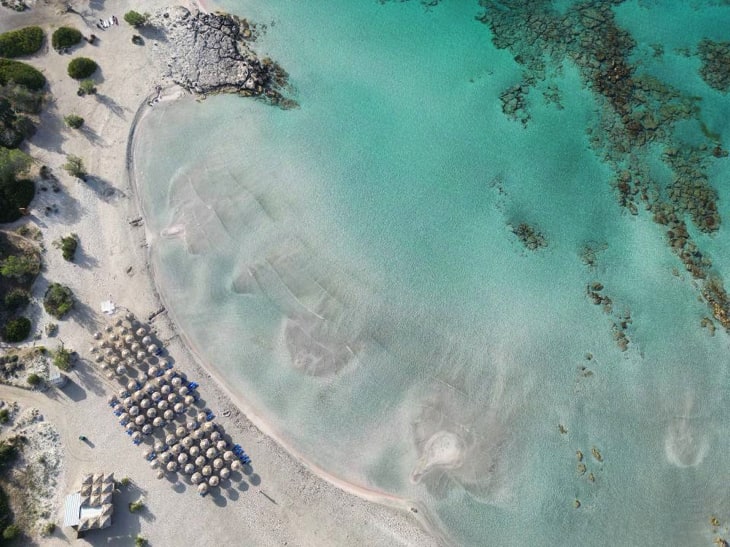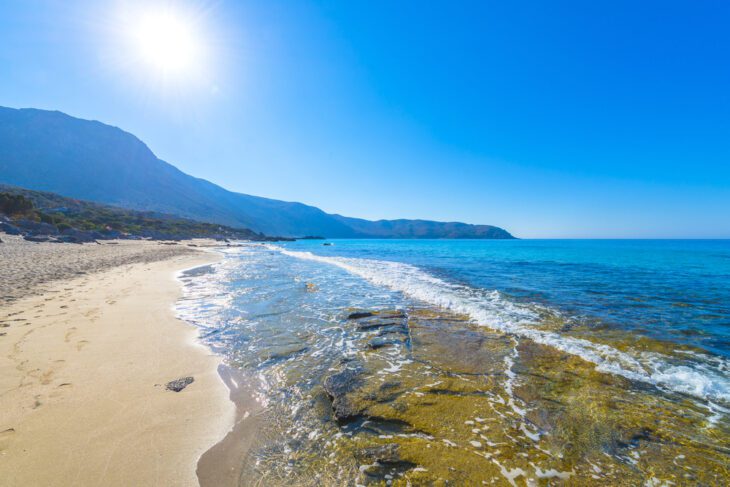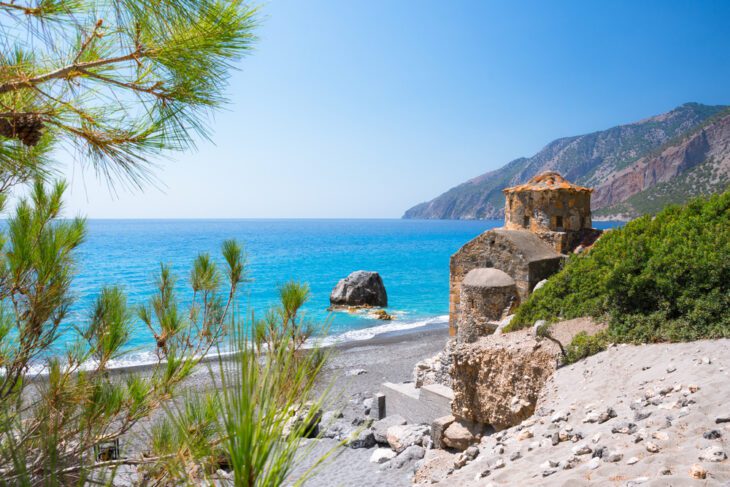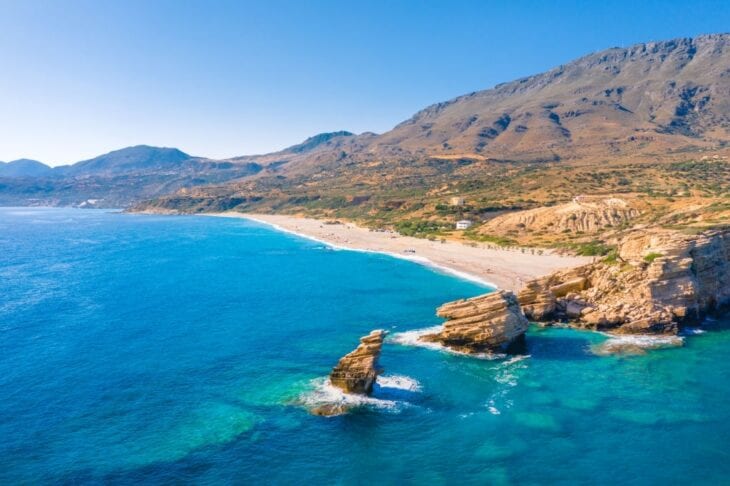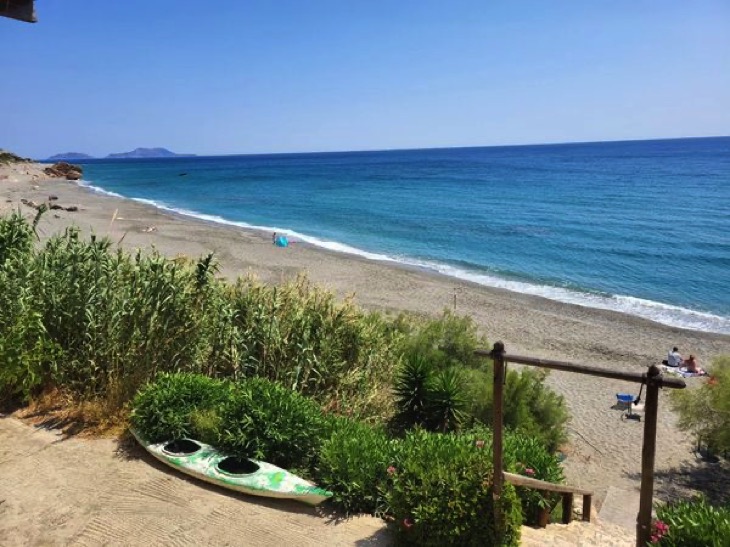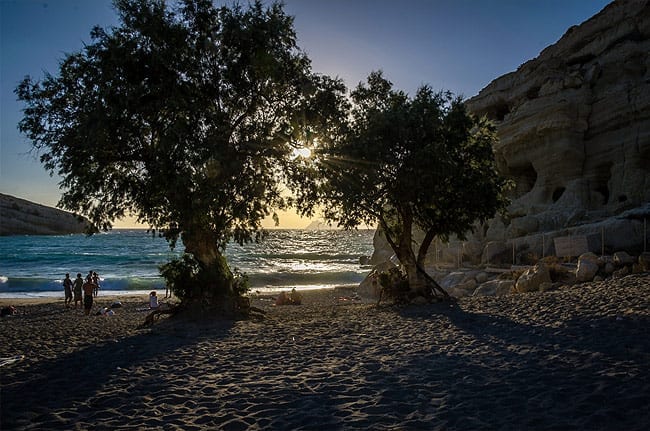Nudist Beach in Crete (Naturist Beach): Things to Know Before you Get There
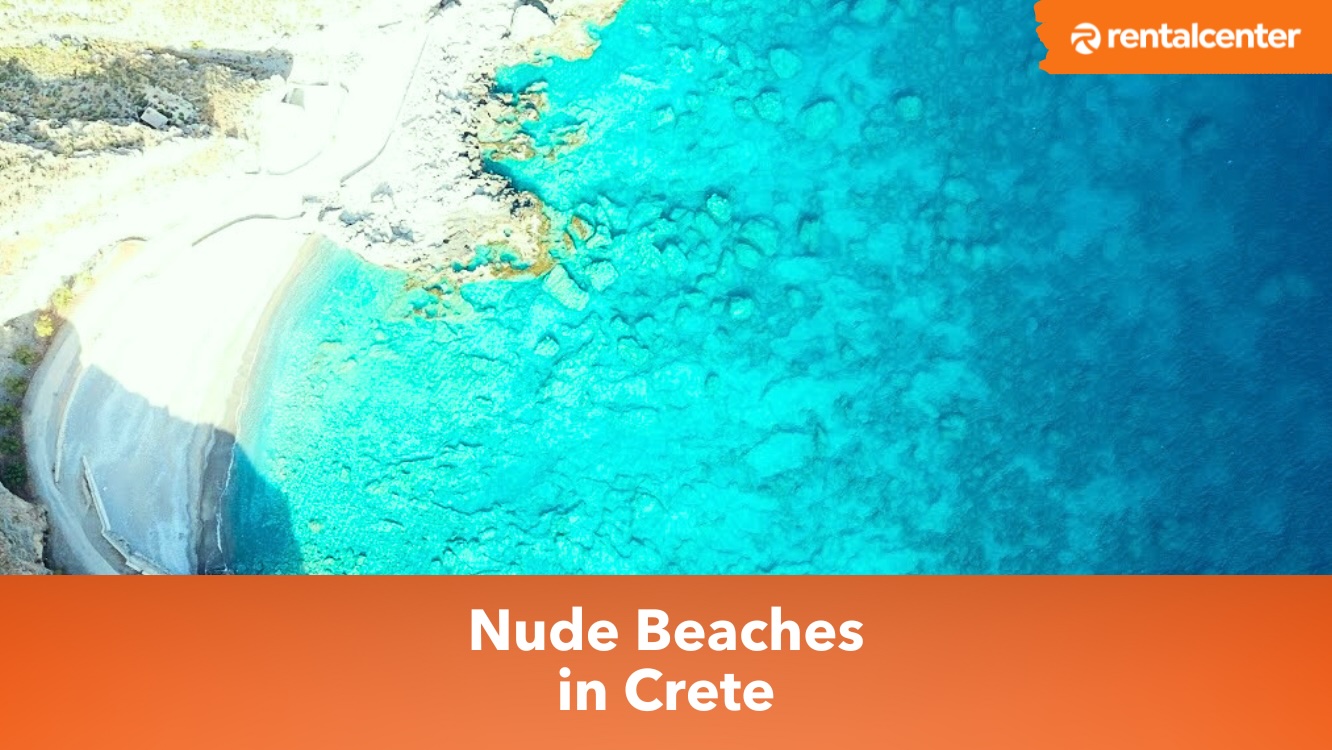
A nudist beach, commonly known as a naturist beach, in Crete, encompasses carefully designated areas where individuals luxuriate in sunbathing, swimming and engaging in recreational activities without clothing. These nude beaches in Greece, predominantly situated in secluded and distant locations, provide a haven of privacy and an invigorating sense of liberation for those who revel in the naturist lifestyle.
Visitors must adhere to a set of unspoken guidelines and expectations when venturing to a nudist beach in Crete. It is essential to exercise the utmost respect for the comfort and privacy of fellow beachgoers while authorities do not rigorously enforce official regulations. Common courtesies include upholding personal hygiene, refraining from any form of inappropriate behaviour and displaying unwavering consideration for the sensibilities of others who share the beach.
The island boasts an array of secluded and unspoiled coastal stretches where the practice of naturism is generally tolerated, although Crete does not have officially designated nudist beaches. These hidden gems are often nestled away in tranquil and untrammelled areas, far removed from the bustling tourist hubs. It is essential to keep in mind that the level of acceptance for nudism varies depending on the time of year, local customs and the availability of supporting beach amenities.
Opting for a rental car to reach a nudist beach in Crete proves to be a practical choice, as it affords visitors convenient access to remote locales. However, it is vital to exercise prudence in selecting an appropriate parking spot and adhering to any stipulations or guidelines laid out by local authorities or beach management. Prior research into the precise location of the nudist beach is strongly advised, allowing for meticulous planning to ensure a seamless and gratifying experience.
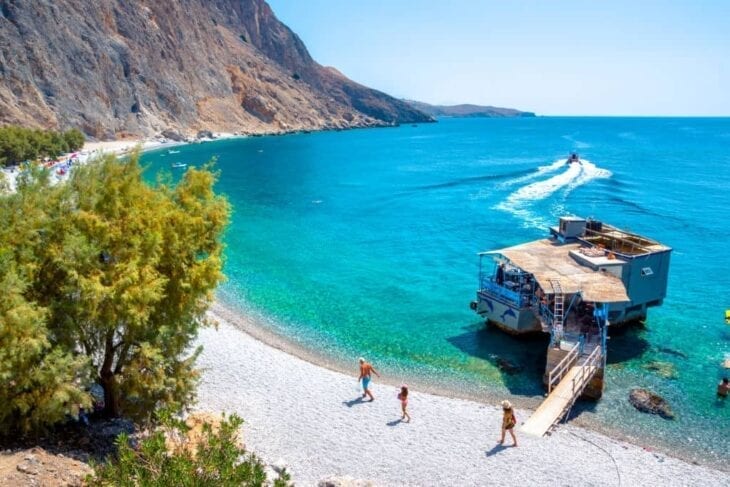
A visit to Crete’s nudist beach necessitates a profound appreciation for naturist culture, coupled with an unwavering commitment to observe any unspoken rules of conduct and exhibit the utmost respect for fellow beachgoers. Embracing the naturist lifestyle remains a deeply personal choice and visitors must approach these beaches with an attitude of open-mindedness and considerate comportment.
What is a Nudist Beach in Crete?
A nudist beach in Crete refers to a beach where naturism, the practice of social nudity, is permitted and embraced. These beaches provide a space for individuals who wish to sunbathe, swim or engage in recreational activities without clothing. Nudist beaches are typically located in secluded or remote areas, away from more crowded and family-oriented beaches. They offer a sense of privacy and freedom for those who enjoy a naturist lifestyle on the nude beach in Crete. Visitors expect to find beautiful stretches of coastline with clear waters and picturesque landscapes. The atmosphere on most nudist beaches in Crete is relaxed and accepting, where people of all body types feel comfortable and respected. Most beachgoers on a nudist beach enjoy the freedom of connecting to nature and embracing their bodies.
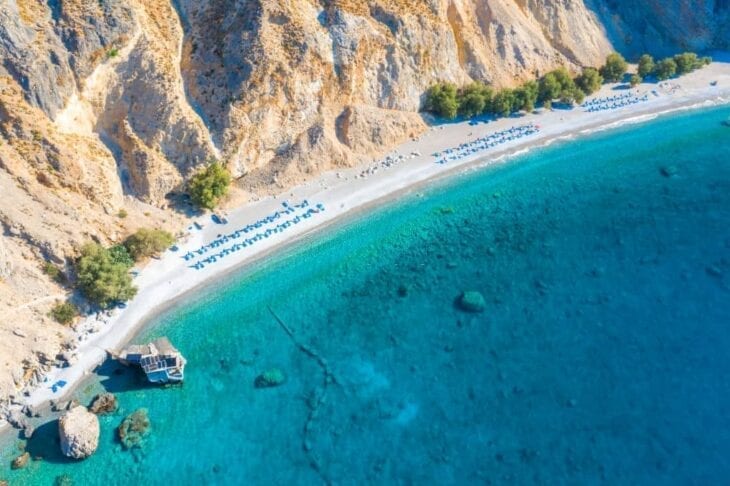
Nudism is a personal choice and these designated beaches provide a comfortable environment for individuals to express themselves and enjoy a natural and clothing-free experience. It’s important to note that while nudity is tolerated in certain areas of Crete, it is not widely accepted or practised throughout the island. Respect for others and local customs is paramount when visiting a nudist beach, ensuring a harmonious experience for all beachgoers. A visit to a nudist beach in Crete offers an opportunity to embrace naturism, connect with nature and enjoy a liberating beach experience in a welcoming and serene environment.
What are the rules for the Nudist Beach in Crete?
There is no official designated nudist beach in Crete. Naturism is tolerated in certain remote and secluded areas. However, there are rules that beachgoers must always remember whenever going to any beach. Firstly, it’s crucial to choose a secluded and remote beach where naturism is tolerated. These areas are often far from populated or family-oriented beaches. Respect for others is crucial, so be mindful of one’s behaviour and avoid any actions that make others uncomfortable. It’s recommended to practise discretion and avoid engaging in explicit or sexual behaviour. Additionally, it’s advisable to bring one’s own towels or beach chairs and maintain a respectful distance from other beachgoers. Lastly, remember that while naturism is tolerated in certain areas, it is not widely accepted throughout Crete, so it’s essential to be considerate of the local culture and customs.
Is there an Official Nudist Beach in Crete?
No, there is no official nudist beach in Crete. However, there are many beaches that are nudist-friendly. Naturism is only officially allowed in a limited number of licensed areas in Greece, but there are several places where it is tolerated. These are usually peaceful and secluded beaches or coves. However, it’s essential to be aware that the situation changes unexpectedly, such as when a beach canteen is established and a “No Nudity” sign is put up.
Remember that when visiting a specific country, it’s best to avoid intentionally shocking the locals. It’s worth noting that Crete, in particular, is a region with deep traditional values and public nudity on the beaches is likely to cause discomfort among the local population. So, it’s wise to be considerate of the local customs and sensitivities while enjoying the beautiful beaches of Greece.
Are the Beaches in Crete Exclusive Only for Nudists (Naturists)?
No, the beaches in Crete are not exclusively for nudists (naturists). Crete offers a wide range of beaches that cater to different preferences and comfort levels. The majority of beaches on the island are not exclusive to nudists, while there are specific beaches in Crete that are designated or known as nudist beaches.
Crete is a popular tourist destination with a variety of beaches perfect for different types of visitors. The island has beaches suitable for families, beaches with water sports, beaches ideal for quiet reflection and beaches frequented by nudists. Nudist beaches are typically marked or identified, allowing visitors who are comfortable with nudity to enjoy the freedom of sunbathing and swimming without clothing.
It’s important to note that nudism in Greece, including Crete, is generally accepted and regulated. However, it is always advisable to respect local customs and guidelines. Nudism is typically practised in designated areas to maintain a balance between different beachgoers’ preferences and ensure the comfort of all visitors.
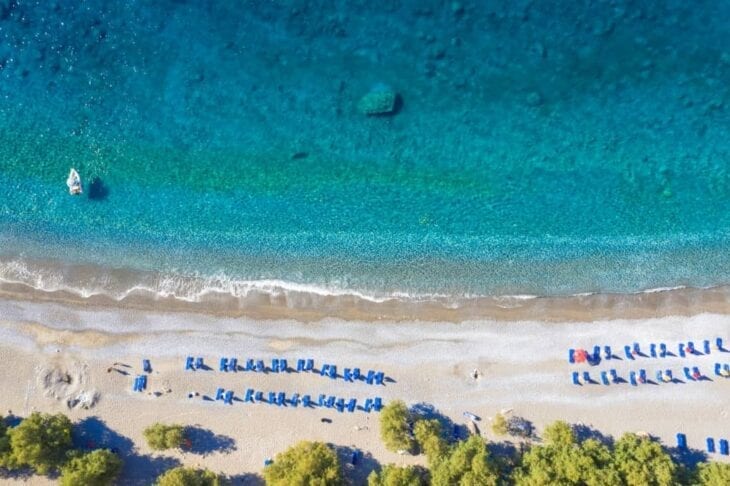
One finds numerous options available throughout Crete if one prefers to visit non-nudist beaches. These beaches are open to all visitors and offer the opportunity to enjoy the sun, sea and sand while adhering to typical beachwear norms.
Crete provides options to accommodate different preferences, whether someone is interested in visiting a nudist beach or prefers a more traditional beach experience. It’s recommended to research specific beaches in Crete and inquire locally to find the type of beach that aligns with someone’s desired experience.
Can I Drive a Rental Car to Get to the Nudist Beach in Crete?
Yes, anyone can drive a rented car to get to the nudist beaches in Crete. Most nudist beaches in Crete are located in remote areas, making it difficult for visitors to reach them by public transportation. However, most auto rental companies do not have specific policies that prohibit driving their vehicles to certain locations, including nudist beaches. They are likely to impose restrictions based on cultural norms, concerns about cleanliness or potential damage to the vehicle. It is essential to clarify these restrictions directly with the rental company to ensure compliance with their terms. It is recommended to communicate directly with the rental car company, research the local laws and regulations and respect any guidelines or restrictions in place for both the rental vehicle and the nudist beach to ensure a smooth and hassle-free experience.
Renting a car provides the freedom to create one’s own itinerary and explore remote areas at one’s own pace. Anyone has the flexibility to choose where to go, when to go and how long to stay. It allows anyone to deviate from traditional tourist routes and discover hidden gems that are not easily accessible by other means of transportation. Renting a car enables one to access remote destinations, secluded beaches, picturesque countryside or off-the-beaten-path hiking trails that are otherwise inaccessible.
Why is Nudist Beach in Crete Known as the Best Sun Bathing Destination?
The nudist beaches in Crete have gained a reputation as some of the best sunbathing destinations for several reasons. Firstly, the island of Crete boasts stunning natural beauty, with pristine coastlines, crystal-clear waters and picturesque landscapes. It creates a serene and idyllic atmosphere, perfect for sunbathing in the nude. Additionally, the warm Mediterranean climate of Crete provides ample sunshine throughout the year, making it an ideal destination for sun worshippers. The nudist beaches in Crete offer a sense of freedom and liberation, allowing visitors to connect with nature and enjoy a more natural and unrestricted sunbathing experience. Nudism is often associated with a sense of freedom, liberation and body positivity and these beaches offer a space where individuals feel comfortable and confident in their own skin. Moreover, these beaches often have well-maintained facilities and amenities, ensuring the comfort and convenience of visitors. The combination of breathtaking surroundings, favourable weather and a welcoming atmosphere makes the nudist beaches in Crete the preferred choice for those seeking a top-notch sunbathing experience.
What to Bring to a Nudist Beach in Crete?
Listed below are Things to Bring to a Nudist Beach in Crete.
- Towel or Sarong: Bring a towel or sarong to sit on and use for drying off. It provides a barrier between an individual and the sand or rocks.
- Sunscreen: Protect the skin from the sun’s rays by bringing and applying sunscreen. Choose a broad-spectrum sunscreen with a high SPF to protect all exposed areas of the body.
- Hat and Sunglasses: Shield the face and eyes from the sun by wearing a wide-brimmed hat and sunglasses. They provide additional protection against harmful UV rays.
- Water and Snacks: Stay hydrated by bringing a water bottle. It’s important to drink plenty of water, especially in hot weather. Consider packing some light snacks to keep someone energised throughout the day.
- Beach Bag: Carry belongings in a beach bag that is easy to transport. Choose a bag that is large enough to hold some essentials like sunscreen, towel, water bottle and personal items.
- Flip-flops or Sandals: Protect the feet from hot sand or rough surfaces by wearing comfortable flip-flops or sandals. They are convenient for walking to and from the beach.
- Extra Clothing: Bring a cover-up or light clothing if someone plans to leave the nudist beach area and explore the surrounding area. It’s important to have something to wear when transitioning between the beach and other public spaces.
- Snorkelling Gear: Bring one’s own snorkelling gear to explore the underwater world if someone enjoys snorkelling. Check if the nudist beach offers suitable snorkelling opportunities before bringing one’s equipment.
- Respectful Attitude: It’s crucial to bring a respectful and open-minded attitude, although it’s not a physical item. Embrace the naturist culture, respect others’ privacy and personal boundaries and be considerate towards fellow beachgoers.
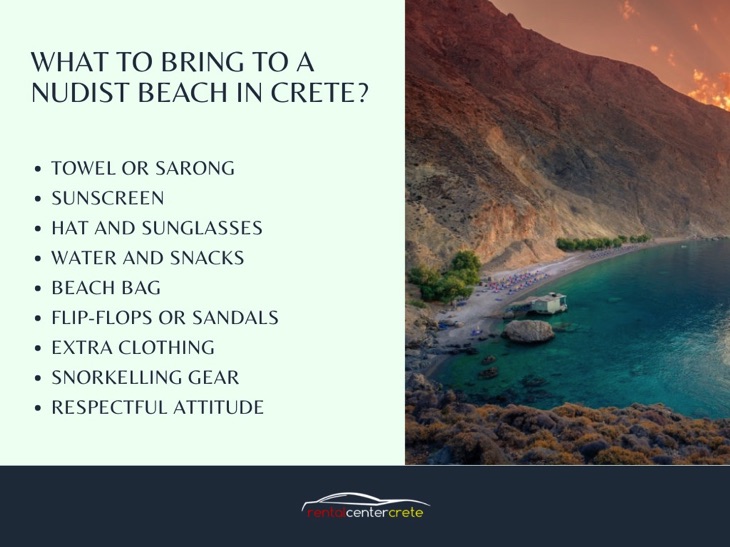
What Should be the Etiquette of Tourists Visiting the Nudist Beaches in Crete?
Listed below are the Etiquette for Tourists Visiting the Nudist Beaches in Crete.
- Respect Privacy: Recognise that nudist beaches are spaces for people to enjoy naturism without judgement or intrusion. Respect the privacy of others by maintaining a reasonable distance and refraining from staring at or taking photographs without permission.
- Follow Local Rules: Be familiar with any specific rules or regulations that apply to the nudist beach anyone is visiting. Some beaches have designated clothing-optional areas or specific guidelines for behaviour.
- Dress Appropriately: Ensure to get appropriately dressed before entering or leaving the nudist area. Carry a towel or sarong to sit on and use it when walking to and from the beach.
- Practise Good Hygiene: Maintain good personal hygiene by showering before entering the beach. It is advisable to bring a towel to sit on to keep the beach clean.
- Carry Essentials: Bring beach essentials such as towels, sunscreen, water and any personal items someone is going to need. Respect the environment by cleaning up after oneself and disposing of any trash appropriately.
- Be Mindful of Children: People who are visiting with children, must ensure they are aware of the nudist beach environment and teach them to respect others’ privacy. It is essential to monitor their behaviour and ensure they follow the etiquette guidelines.
- Engage in Natural Behavior: Embrace the naturist culture by being comfortable with one’s own nudity and respecting others who choose to be nude. Avoid engaging in any sexually suggestive or inappropriate behaviour.
- Be Friendly and Polite: Maintain a friendly and polite demeanour towards fellow beachgoers. Greet others with a smile, but always respect their boundaries and personal space.
- Keep Noise Levels Down: Nudist beaches are often places of relaxation and tranquillity. Keep noise levels to a minimum to ensure a peaceful environment for everyone.
- Be conscious of Photography: Respect the privacy of others by refraining from taking photographs or videos without explicit permission. It is best to ask for consent before capturing any images.
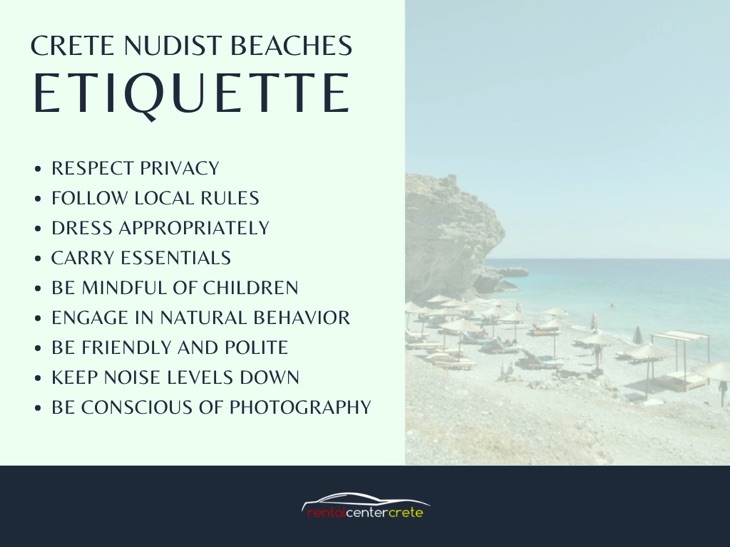
What are Crete’s Popular Beaches in Chania Regional Unit South Coast?
Listed below are Crete’s Popular Beaches on the Chania Regional Unit South Coast.
- Filaki Beach: Nestled amidst a picturesque backdrop, Filaki Beach reveals a tapestry of pebbles adorned with fascinating rock formations, both above and below the water’s surface. Shielded from the elements by surrounding cliffs, the coastal haven boasts tranquil waters along the shoreline, undisturbed by the tumultuous embrace of strong waves. The entry into the water is on a gentle slope, paved with rocks, necessitating the use of specialised swimming shoes for added convenience and comfort. The crystalline expanse of water exhibits remarkable clarity, displaying a vibrant palette of brilliant blues tinged with a mesmerising hint of green. Temperatures average a balmy +25°C, inviting swimmers to indulge in the refreshing embrace of its azure depths during the summer months. Its allure goes beyond its reputation as a quiet getaway, while nudists adore Filaki Beach. The beach boasts a well-developed infrastructure, offering essential amenities to visitors. A parking lot provides convenient access for those arriving by private vehicle, while well-maintained water closets ensure comfort and convenience. Bars dotting the shoreline offer respite and refreshments, while sling chairs and umbrellas provide a touch of indulgence amid the serene surroundings. Filaki Beach remains a haven of tranquillity, avoiding the crowds that often accompany more frequented destinations despite its accessibility and favourable transport links. A leisurely stroll leads to the beach’s tranquil shores for those residing in Sfakion. Others opt to rent a car, on the other hand or avail themselves of the daily public transport service departing from Chania to Hora-Sfakion at 2 p.m.
- Agios Charalambos: Nestled adjacent to an exclusive nudist hotel, the picturesque cove of Agios Charalambos unveils its splendour. Situated 1.5 kilometres east of Chora Sfakion and 75 kilometres south of Chania, the coastal paradise resides in an area adorned with a collection of contiguous pebbly beaches. The beachfront encompasses a series of 3-4 secluded coves, with Sfakiano Ammoudi preceding Agios Charalambos. A five-minute traverse through rocky terrain leads to the hallowed, cavernous church of Saint Charalambos, a revered figure deeply esteemed by the Sfakian community. Historically, Saint Charalambos safeguarded people against the perils of the plague, prompting the construction of chapels dedicated to his veneration at village entrances. However, at Sfakia, where seafaring was essential to keeping in touch with the outside world, the temple was built near the coast. These captivating coves, alongside the neighbouring Filaki Beach, predominantly attract nudists, representing one of the nudism-friendly beaches on the island of Crete, owing to the presence of the nudist hotel. These pebbled shores remain exposed to occasional southerly winds, adding an element of natural intrigue. These beaches are secluded and undeveloped, with no lodging, water sports facilities, loungers or lifeguards. However, a solitary canteen awaits beachgoers at Filaki Beach, accessible by car.
- Glyka Nera: Glyka Nera, meaning “sweet water”, stands as a beacon of natural beauty and is widely regarded as one of the most exquisite beaches in Crete. Its azure waters exude a profound shade of blue, while the pebbles that adorn its shores add a touch of elegance. The esteemed London Times honoured Glyka Nera in 2003 by placing it among the top 20 beaches in Europe in recognition of its allure. The name itself finds its origin in the pure and refreshing freshwater that gracefully springs forth from within the pebbles, enhancing the beach’s captivating charm. Typically, boats are the main mode of transportation to Glyka Nera. However, for the intrepid and adventurous, alternative pathways exist for those wishing to embark on a more daring journey. One such path commences from Chora Sfakion, encompassing a 30-minute trek from the nearest parking area above Iligas Beach. Another route commences from Loutro, although it necessitates a more arduous hike of approximately 60 minutes, with portions of the trail requiring careful navigation near the cliff edge. It is significant to note that local authorities diligently maintain both pathways, which are an integral part of the European E4 footpath, despite the occasionally challenging views. A small tavern, perched upon a rocky outcrop, welcomes visitors upon arrival, offering a delectable array of food, refreshing cold beverages and comfortable seating options. The presence of a natural spring eliminates the need to carry drinking water, as the water is potable and readily available. The seawater at Glyka Nera retains a refreshing coolness throughout the year, owing to the presence of these natural springs. Bathers expect an invigorating dip in the crystal-clear waters, even during the height of summer. The beach boasts the pleasant presence of several tamarisk trees, offering precious shade to those seeking respite from the sun’s embrace.
- Ilingas: Ilingas, derived from the Greek word for “vertigo”, embraces its namesake at the exit of the mesmerising gorge bearing the same title. Located approximately 2 kilometres west of Chora Sfakion, along the road to Anopolis, such an enchanting beach beckons visitors with its awe-inspiring beauty. The journey to reach its shores entails a transition from vehicular travel, as the road culminates at the parking area of a nearby hotel, where essential supplies are obtained. A short, leisurely stroll along an easily traversed path reveals the splendour of such an extraordinary beach, adorned with smooth pebbles and crystalline waters. While a few sunbeds and umbrellas grace the main beach, those seeking an alternative venture eastward, discovering the sheltered embrace of captivating caves that offer respite from the scorching sun. Two additional hidden gems await discovery beyond the main expanse of Ilingas Beach. These secluded treasures often remain unoccupied, accessible solely through a combination of swimming prowess and the availability of boats or kayaks. An eastern trajectory spanning 80 metres towards Chora Sfakion unveils the beauty of the second beach for the intrepid souls endowed with swimming skills and daring spirits. Continuing onward with a 100-metre swim reveals the allure of the third and final beach, completing a triumvirate of coastal marvels. Ilingas Beach, characteristically free from overcrowding, offers a haven of tranquillity easily reached via a brief 15-minute walk from Chora Sfakion. The captivating destination stands as an essential pilgrimage for those fortunate enough to find themselves in the embrace of Sfakia. An excursion to Ilingas is seamlessly intertwined with a visit to the traditional village of Anopolis, the impeccably preserved Frangokastello Castle, the haunting ghost village and the resplendent Aradena Bridge.
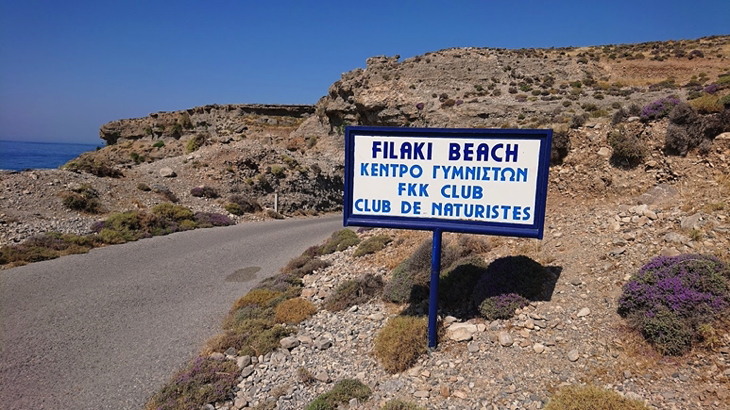
What are Crete’s Popular Beaches in Chania West Coast?
Listed below are Crete’s Popular Beaches on the Chania West Coast.
- Elafonisi Beach: Elafonisi is found 76 kilometres to the west of Chania and five kilometres to the south of the Chrysoskalitisa Monastery. It occupies the southwesternmost point of Crete and is a designated Natura 2000 protected area. The elongated peninsula, at times appearing as a separate island due to its division by water, showcases an array of natural wonders. The landscape is adorned with sand dunes adorned with sea daffodils and junipers, providing a sanctuary for endangered loggerhead sea turtles and a multitude of rare flora and fauna. A strict preservation policy prohibits the removal of any plants, animals, shells or sand from the region. The allure of Elafonisi lies in its exotic beaches, reminiscent of the paradisiacal shores of the Caribbean, with powdery white sand and shimmering turquoise waters. The sand takes on a delicate pink hue in many areas as a result of countless crushed shells. The sea adopts a shallow depth of no more than 1 metre near the peninsula’s breaking point, forming a tranquil lagoon that is particularly suitable for children. Visitors are able to conveniently traverse the lagoon while carrying their belongings, as the water remains shallow in the area. The eastern side of the beach, facing the lagoon, is well-appointed and draws the largest crowds. One finds umbrellas, showers, lifeguards, snack bars and changing rooms at Elafonisi Beach. A spacious parking area is available adjacent to the beach and a few guest rooms are found further afield. Finding parking in Chania is a bit challenging during the peak tourist season, so it’s advisable to arrive early at Chania’s west coast beaches. A leisurely walk along the peninsula reveals secluded coves of exceptional beauty for those seeking solitude or the freedom of nudity. Naturists discover suitable enclaves for their preferences, particularly towards the western end of the peninsula. Getting to Elafonisi from Chania requires a 1.5-hour drive by car or by bus. The awe-inspiring scenery that unfolds along the route, including the verdant village of Elos and the grandeur of the Topolia Gorge, compensates for any inconveniences. The road to Elafonisi is narrow and winding. Visitors in search of accommodation find numerous options in the nearby village of Chrisoskalitissa, situated 5 kilometres to the north. Dining options are available in both Chrisoskalitissa and Elos, making for a rewarding culinary experience on the return journey to Chania.

- Kedrodasos: Kedrodasos, an extraordinary beach situated 76 kilometres southwest of Chania and 1 kilometre east of the renowned Elafonissi lagoon, is a sight to behold. Kedrodasos Beach, enveloped by an enchanting juniper forest (often misidentified as cedars), is characterised by its impressive sand dunes. The shoreline is adorned with small, intricately twisted juniper trees, namely Juniperus oxycedrus subsp. macrocarpa and Juniperus phoenicea species. It is imperative to treat these delicate trees with utmost reverence when exploring Kedrodasos. Spanning an expansive area of approximately 11 hectares, the “cedar” grove boasts an awe-inspiring ambience. It serves as an idyllic destination for both swimming enthusiasts and naturists alike. The beach itself features pristine white sand, intermittently dotted with smooth and flat rocks. Fortunately, the absence of nearby facilities preserves the secluded nature of the untouched paradise, rendering it one of the last unspoiled havens in Europe. It is imperative, therefore, to maintain the beach’s cleanliness and refrain from littering. The wider expanse surrounding Kedrodasos is regarded as an ideal haven for avid wind- and kitesurfing aficionados. The prevailing winds are consistently robust, creating a haven of tranquility with a calm, glassy sea surface. Kedrodasos stands as a truly remarkable beach that beckons with its unique juniper woodland, breathtaking natural features and seclusion. Its allure lies in its untouched splendour, making it a destination that warrants reverence and environmental responsibility.

- Domata Beach: Domata, an exquisite beach situated at position Tseses, lies 7 kilometres east of Sougia and 58 kilometres south of the city of Chania. Its existence owes itself to the conclusion of the rugged and untamed Klados Gorge, resulting in the formation of a remarkable natural monument. The name “Domata”, meaning “roofs”, stems from the awe-inspiring arrangement of conglomerate rocks that resemble colossal walls. The continuous influx of pebbles and sediment carried by the gorge, coupled with the ceaseless interplay of the sea and wind, has contributed to such a remarkable spectacle. Domata Beach captivates visitors with its pristine beauty, characterised by its smooth pebbles and crystalline cerulean waters. A fascinating feature awaits those who delve into the sand, the discovery of underground springs, offering access to fresh water. The absence of roads and infrastructure in the area preserves its unspoiled nature. The abundance of pine trees surrounding the beach provides natural shade, presenting an enticing opportunity for camping enthusiasts. A distinct section of the beach, known as Kolotrividis, lies to the south, distinguished by its rocky seclusion from the main expanse of Domata. Accessing Domata is possible through the E4 European Trail, which meanders eastward and leads to Agia Roumeli, a journey requiring a 3 to 4-hour hike. However, caution is advised as certain sections of the trail exhibit steep and treacherous slopes, ascending to an altitude of 700 metres. Domata Beach offers a captivating landscape that harmonises the raw beauty of the Klados Gorge’s conclusion with the mesmerising interplay of sea, wind and geological formations. Its secluded ambience, absence of modern amenities and pristine natural attributes make it a destination of immense allure.
What are Crete’s Popular Beaches in Chania North Coast?
Listed below are Crete’s Popular Beaches on the Chania North Coast.
- Choni: Located merely 2 kilometres to the east of Nopigia, the rugged coastal landscape of Choni unveils itself with resplendent grandeur. One must embark upon the scenic seaside road that gracefully winds its way from Nopigia towards the eastern horizon to reach such a captivating enclave. An unassuming dirt road beckons, guiding intrepid souls towards the ethereal realm of Choni and the revered Panagia church, commonly known as Santa Maria, upon passing the quaint square theatre of the Orthodox Academy. It is within such a realm that nature’s artistry flourishes, as breathtaking rock formations bestow upon the landscape a sublime and untamed beauty. Discreet rocky coves emerge amidst the rugged contours, offering respite and opportunity for refreshing swims. The crystalline waters, remarkably transparent, boast a captivating palette of radiant blues and greens, inviting seekers of solace to immerse themselves in their serene embrace, particularly on tranquil days untouched by the whims of the wind. Scant foliage, affording scant natural shade, bestows a sense of seclusion upon visitors, evoking an ambience untethered from the trappings of civilization. Nevertheless, the proximity of Nopigia, a mere stroll away, provides a gentle reminder of the human touch in the otherwise pristine sanctuary.
- Agios Pavlos: Nestled along the captivating coastline, the serene village of Agios Pavlos, commonly known as St. Paul, gracefully unfolds its enchanting allure. Situated 58 kilometres to the south of Rethymnon city and west of Agia Galini, the hidden gem is tucked away on a secluded bay, welcoming visitors looking for peace and quiet for peaceful family vacations. Embraced by the azure waters, the bay reveals a pristine beach adorned with verdant depths and a majestic rocky seabed. A handful of inviting rooms and taverns await, ensuring both comfort and delectable culinary experiences adjacent to such an idyllic shoreline. Catering to the needs of beachgoers, the beach provides essential amenities such as umbrellas, sunbeds and pedal boats. Perched above the beach, the modest church of Saint Paul stands as a testament to the area’s historical significance, as legend has it that Saint Paul sought refuge here during the apostle’s voyage to Rome, a narrative shared by select locales across Crete, including Kali Limenes and Selouda. Some discerning visitors opt to make Agios Pavlos their base for accommodation and dining while venturing to the nearby paradisiacal expanse adorned with colossal sand dunes. The village’s own beach possesses its own charm at the same time. Known as Akoumiani Gialia or Melissa, the exquisite beach resides just beyond the western fringes of Agios Pavlos Bay. It is renowned as one of the crown jewels of Rethymno prefecture, despite its propensity for gentle waves. An enchanting path commences from Agios Pavlos to access the pristine haven, inviting intrepid explorers to embark on a journey of unparalleled natural splendour.

- Menies: Menies, sometimes known as Diktynna, is nestled in a serene coastal enclave, unveiling its captivating allure on the northeast shores of the Rodopos Peninsula, situated 45 kilometres northwest of Chania. Sheltered by the majestic Foundas Gorge, such a secluded beach, adorned with smooth pebbles and translucent azure waters, remains unaffected by the customary winds that grace the surrounding area, offering an idyllic haven of isolation far removed from urban centres. Spanning vast kilometres, the landscape bears no trace of modern civilization, making it imperative to equip oneself with all essential provisions for a sojourn in such a pristine realm. Accessing the coveted shores of Menies requires traversing a lengthy and rugged dirt track, approximately kilometres in length. Commencing from Rodopos village, a route that demands caution for low-riding vehicles. A selection of small boats provides transportation to Menies from Platania Harbour, offering a scenic and leisurely voyage. Menies hold historical significance as the site of ancient Diktynna, housing the esteemed temple dedicated to the goddess Vritomartis, a Cretan incarnation of Artemis. Its revered sanctuary attracted throngs of devotees from across the island, traversing the well-preserved paved road that once connected the temple to the town of Polirinia. The vestiges of the Hellenistic temple have regrettably eluded discovery, while remnants of the ancient Roman temple are still to be discerned. Journeying approximately one-kilometre southwest of the beach, one encounters the venerable St. George Monastery, a testament to the passage of time, having been constructed in the 9th century. Abandoned centuries later amidst the ravages of pirate raids, the monastery’s courtyard still boasts the protective tower, dating back to the 16th century, which served as an early warning system against marauding pirate vessels. A collection of petite coves, formed at the mouths of meandering streams, entice exploration, beckoning travellers to venture forth on foot or by boat en route from Menies to Afrata. One finds an enchanting bay nestled beneath the auspices of the St. George Monastery among these hidden treasures, while the most captivating of all is the ethereal Xeronissia.
- Ravdoucha: Situated along the western coasts of the Rodopos Peninsula, the beachfront of Ravdoucha unveils its picturesque charm a mere 21 kilometres west of Chania, in close proximity to the eponymous Ravdoucha village. Adorned with a magnificent landscape boasting rugged mountains, untamed rock formations and flourishing olive groves, the region captivates the senses. Nestled within its embrace lie several small bays adorned with pebbles and breathtaking rock formations, offering a sublime haven for exploration. The sea, often influenced by the western winds, entices snorkelers with its crystalline depths, inviting immersive encounters with the underwater world. The small but renowned selection of fish taverns and basic tourist amenities in Ravdoucha more than makeup for the lack of umbrellas. A well-maintained paved road that branches off the Chania-Kissamos highway makes it easy to reach Ravdoucha. Perched upon an elevated vantage point overlooking the sea, the village emanates an enchanting allure. One comes across the intriguing cavernous chapels of St. Marina and St. Onoufrios, tempting the lens of the keen photographer on the way to the shore. Tucked away in the northernmost reaches of the area lies Neratzia, a serene sandy beach that derives its name from a quaint tavern nestled nearby. The beach exudes peacefulness and features a small pier that serves as a harbour, adding a touch of maritime elegance to its quiet environment.
What are Crete’s Popular Beaches in Rethymnon South Coast?
Listed below are Crete’s Popular Beaches on the Rethymnon South Coast.
- Triopetra: Triopetra sits 52 kilometres south of Rethymno and 13 kilometres southeast of the settlement of Akoumia, at the foot of the majestic Siderotas mountain. The beach is easily accessible by automobile along well-maintained roads running from either Akoumia or Sachtouria. Triopetra is located in the centre of a long beachfront stretch known as Akoumiani Gialia or Akoumia Beach. Such terminology derives from the area’s historical use as a winter shelter for residents of Akoumia village, who built tiny cottages to spend the night amid their olive groves. The majority of the landowners are still Akoumia residents, as are many of the hotel proprietors. Triopetra is made up of two unique beaches separated by a short peninsula. Three spectacular rocks rise along the peninsula’s edge, gracefully emerging from the sea, providing the beach with its name, as “Triopetra” literally translates to “Three Rocks”. The first beach, known as Small Triopetra or Koumado, is located south of the three rocks in a sheltered sandy and rocky harbour. The Akoumianos River gently meanders through the Triopetra area, separating the picturesque Agios Pavlos Sandhills beach at Cape Melissa from the Triopetra area. There are a few hotels and bars and umbrellas are available for use along the beach. Stomio (meaning “mouth”), a little harbour tucked towards the southeastern section of the beach, takes its name from the river’s confluence with the sea. A kilometre northeast of the seashore, on a tall hill overlooking Akoumiani Gialia, is the unique Prophet Elias Chapel. Triopetra’s main beach, known as West Triopetra or Chatzi, continues westward from the rocks for many miles until it meets the Ligres beach. The beach is known for its magnificent coarse sand and stunning water colours because of its west-facing location. The eastern section of the beach has moderate amenities such as taverns, rooms and umbrellas, although it is never overcrowded. A little permanent river even blesses the section of shore, providing pleasant waters all year. A unique, huge cave resembling the Greek letter “Δ” is located near the three rocks, providing pleasant shade, while free camping is prohibited on the beach. The western half of Triopetra is still undeveloped, with a dirt road running beside the beach leading to the nearby Ligres beach.

- Ligres: Nestled at the base of the formidable Siderotas mountain, Ligres beckons from a distance of 51 kilometres south of Rethymno and a mere 7 kilometres south of the village of Kerames. Situated as the northern segment of the expansive Akoumiani Gialia beachfront, which stretches from the Mellissa cape to the south, Ligres unveils its allure. A sprawling expanse of coastline, Ligres boasts an alluring blend of coarse sand and beguiling deep waters. The arduous access to such an idyllic locale has fortuitously deterred excessive tourism development, bestowing upon it the distinction of being one of the island’s most serene and secluded beaches. A smattering of pubs and a number of rooms are found along its western reaches, accessible by a rocky asphalt road, while the beach itself is undeveloped. A captivating waterfall graces its western extremity, enhancing the beach’s natural splendour by cascading harmoniously year-round in proximity to the sea.

- Melissa Cape Sandhills: The awe-inspiring Melissa Cape Sandhills, situated in the heart of central Crete, stand as a testament to the region’s unparalleled natural beauty. Nestled near the picturesque Agios Pavlos, at the southern extremity of the expansive Akoumiani Gialia seafront, these magnificent sandhills captivate the senses. Their allure is further heightened by their proximity to Cape Melissa in the south, spanning approximately 55 kilometres south of Rethymnon city and the meandering Akoumianos River and Triopetra Beach to the north. The Melissa Cape Sandhills entice visitors to indulge in refreshing swims with their inviting deep sea, while the idyllic coves surrounding the beaches provide an ambience of seclusion and privacy. Such serenity encourages individuals to revel in the sun-kissed shores, often adorned in a myriad of beachwear styles or, at times, embracing a more uninhibited approach. These remarkable coastal formations embody the essence of the extraordinary locale locally referred to as “Alatsogremi” or “salt cliffs”.
What are Crete’s Popular Beaches in the Heraklion Regional Unit South Coast?
Listed below are Crete’s Popular Beaches on the Heraklion Regional Unit South Coast.
- Trafoulas: Trafoulas, locally known as Dragon Bay, is situated 4 kilometres east of Lendas and 69 kilometres south of Heraklion. The secluded beach is located in the southern region of Crete and is formed at the mouth of the majestic canyon on Cape Trafoulas or Trahilas. King Minos and the King’s men frequented the beach, while the nearby Loutra beach served as the bathing spot for Minos’s wife, Pasiphae and the Queen’s female entourage, according to legend. It is worth noting that the canyon is often referred to as Steno Faragi (Narrow Gorge), although Steno Faragi actually denotes the narrow section of the Tripiti Canyon. The lower section of the gorge leading to Trafoulas is known as Canyon Pidimatou (Jumping Canyon). It is named so due to its narrowness, which allows animals to jump from one side to the other. One must embark on a journey along a rugged road that originates from Lendas Harbour (in Loutra) and leads to the village of Krotos to reach Trafoulas. A small canyon comes into view on the right-hand side, marking the starting point of a hiking trail that leads to the beach after approximately 500 metres. Visitors are going to be treated to a splendid panorama encompassing the shoreline stretching from Loutra to Lendas along the edge of the untamed road. It is advisable to park the vehicle in a suitable location and follow the trail to the beach, which takes approximately 15-20 minutes on foot. Alternatively, a more accessible, albeit less adventurous, option is to reach Trafoulas by boat from Lendas. The gorge itself is a sight to behold, adorned with vibrant oleander plants.
- Katarti: Katarti is a petite beach nestled at the mouth of a small gorge, situated 73 kilometres south of the city of Heraklion, at the foot of Cape Oxa. The secluded coastal gem finds itself amidst the untamed and awe-inspiring terrain of the Asterousia Range, southwest of the Kofinas summit. Access to the beach is primarily via a rugged dirt road originating from Salamias Bay. However, Katarti is reachable by boat or through a scenic hike from Agios Ioannis or the nearby Tripiti beach, located 2.5 kilometres to the west. The encompassing surroundings of Katarti provide an idyllic setting for fishing enthusiasts, as the rocky seabed remains abundant with fish, despite the unfortunate illegal use of dynamite by certain locals. The beach is bordered by magnificent rocky shores characterised by white pebbles and crystalline depths. Towering cliffs extend from the walls of the gorge into the sea, offering natural protection against the elements and casting cooling shadows throughout the day. The name “Katarti” derives from the Greek word for mast, inspired by a prominent, tall boulder emerging from the sea nearby. Some refer to it as “Arkouda” (bear) due to the intriguing resemblance of the rock formations to a bear.
- Red Beach: The captivating Red Beach, known as Kokkini Ammos, is situated in the vicinity of Moudia, a location positioned 68 kilometres southwest of Heraklion and a mere 800 metres south of the renowned resort of Matala. One needs to set out on a scenic trail beginning north of the settlement of Matala and traversing the Kastri hill to the north to access the enchanting coastal haven. The path is well-marked, ensuring a worry-free journey. The final stretch involves a descent down a steep cliff, though it presents no significant difficulty, while the initial portion of the route entails some rock climbing. The splendid Red Beach unveils itself from a vantage point above after a leisurely 15 to 25-minute walk from Matala and passes through a shepherd’s gate (do remember to close it to prevent the escape of goats). The hilltop vista offers a magnificent view and serves as an ideal spot to witness the breathtaking sunset. A boat ride is possible from Matala Harbour at the cost of approximately 5 euros per trip for those averse to hiking. The secluded beauty of the beach is undeniable, though it is susceptible to the prevailing western winds that often grace the region. The coast is characterised by its reddish sand, derived from the rocks indigenous to the area, as suggested by its name. The azure-green hue of the sea further enhances the already picturesque landscape. There exists a rudimentary stone-walled café (not always open) where refreshments and light fare are procured, although the Red Beach lacks extensive amenities. A few umbrellas dot the shoreline, but if people arrive late, they are gone. Therefore, it is advisable to bring mats and umbrellas because the only sources of natural shade are a few tamarisk trees next to the café.

What are Crete’s Popular Beaches in Lasithi South Coast?
Listed below are Crete’s Popular Beaches on the Lasithi South Coast.
- Katharades: The series of small beaches known as Katharades offers a hidden haven on the island of Crete, located just before the renowned shores of Koutsounari village. The coastal gem is characterised by its rugged beauty and the invigorating presence of strong winds, making it a favoured spot for wind enthusiasts. These successive bays remain relatively undiscovered, despite their proximity to the main road, creating an atmosphere of seclusion and tranquilly rarely found in more popular tourist destinations.
The allure of Katharades lies in its enchanting landscape, where time and erosion have sculpted unique rock formations in the conglomerate soils, adorning the shoreline with captivating natural wonders. The presence of nearby hotels has primarily driven the area’s minor development in recent years, but the overall atmosphere is still genuine and unaltered. Visitors find a few charming restaurants, mini markets and lodgings, along the main road, which connects Ierapetra, Sitia and Makrigialos, maintaining a balance between modern conveniences and the preservation of the area’s natural beauty. Katharades Beach itself boasts a striking contrast of coarse grey sand and large, smooth rocks, interspersed with pockets of soft sand. The availability of renting umbrellas for additional comfort complements the presence of tamarisk trees in providing natural shade. The beach is well-appointed, courtesy of the nearby hotels, offering amenities such as beach volleyball courts, sunbeds, showers and water sports facilities. Katharades Beach proves to be an excellent choice for those seeking leisurely moments. The sea, often calm and serene, invites visitors to take refreshing dips in its cool, deep waters. Access from Ierapetra is effortless thanks to the convenient bus connections between these areas, ensuring that even travellers without private transportation are able to easily explore the coastal gem. Katharades Beach in Crete offers a captivating blend of natural splendour, quiet and modern amenities, making it an idyllic retreat for those who yearn to escape the bustling crowds and immerse themselves in the untamed beauty of the Mediterranean coastline. - Peristeras: Peristeras Beach is situated in a serene location within the eastern region of Ierapetra, in southeast Crete. It is located approximately 2 kilometres from the city of Ierapetra and 27 kilometres from Makrigialos. Peristeras Beach is adjacent to the eastern section of the expansive Agios Andreas (Saint Andrew) Beach. The secluded area is characterised by towering cliffs that envelop the beach, creating a sense of seclusion and quietness. The sandy beach is interspersed with smooth rocks in certain areas. Access to the Peristeras beach area is convenient, as it is easily reached from the central road connecting Ierapetra and Sitia at various points. The road is situated only 100-200 metres away from the beach. There is a second sandy beach located in Peristeras, positioned just beyond the rocky end of the long beach. The secondary beach is accessed via the road. It offers a well-protected setting, shielded from prying eyes, although it is dotted with numerous rocks. Peristeras Beach is known for its rugged terrain and the prevalence of strong winds, particularly during the summer months of July and August. It is considered one of the top 5–6 locations on Crete that experience powerful wind gusts. They remain relatively unknown, despite the close proximity of the bays to the main road and tourists are rarely seen frequenting these consecutive bays. The abundance of rock shelters showcasing distinctive rock formations enhances the area’s captivating beauty.
What are Crete’s Popular Beaches on Lasithi East Coast?
Listed below is Crete’s Popular Beach on Lasithi east Coast.
- Karoumes Beach: Karoumes Beach is 110 kilometres east of Agios Nikolaos and 29 kilometres southeast of Sitia. It takes shape towards the end of the scenic Chochlakies Gorge, which is reachable through the E4 hiking route. Its exact location is in Lassithi Prefecture, East Crete, Sitia Area. The only way to get to the beach is by hiking through the gorge, as the area’s severe topography has prevented the construction of roadways. The water is usually still and features little pebbles since the beach faces east. There are many shade trees and a few pebbles near the beach’s northern end. The beach’s remote location and challenging accessibility make it perfect for anyone seeking privacy. Karoumes Beach is a picturesque and secluded coastal gem nestled on the island of Crete. The pristine beach, located in the region of Chania, offers visitors a serene and unspoiled setting, making it an ideal escape for those seeking peace and natural beauty. Karoumes Beach rewards adventurers with its crystal-clear turquoise waters, soft golden sands and breathtaking cliffs that surround the cove, accessible only by boat or a challenging hike. The absence of commercial facilities and the limited number of visitors enhance the sense of seclusion, allowing beachgoers to immerse themselves in the untouched splendour of the Mediterranean. Snorkelling in the azure waters or simply basking in the serenity of the surroundings, Karoumes Beach promises a rejuvenating and unforgettable experience for nature enthusiasts and those in search of a true hidden gem in Crete.
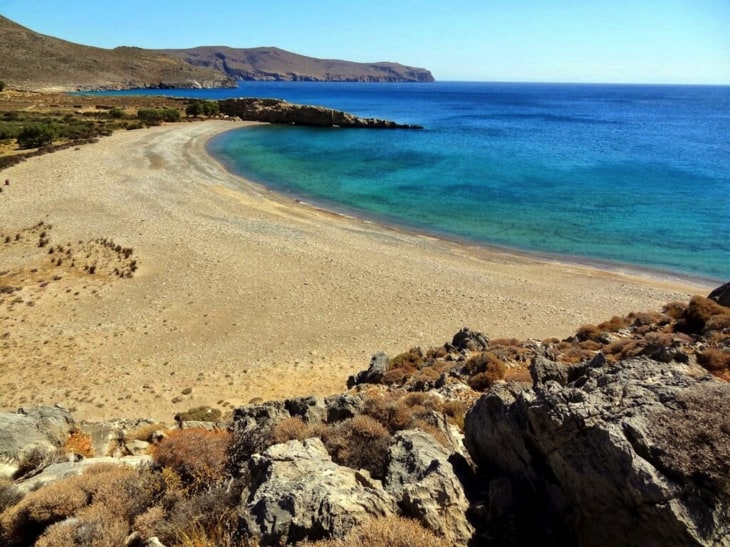
How Much Does a Rental Car in Crete Cost?
Renting a vehicle is undoubtedly the optimal choice for travellers seeking convenience and flexibility while exploring the captivating island of Crete. Visitors effortlessly navigate their way to Crete’s most alluring destinations, unlocking a world of possibilities and immersive experiences with a rented car. The average daily rate typically falls within the range of €30 to €40. The cost of Crete car rentals varies based on factors such as group size, itinerary, preferred car type, desired destinations and duration of the rental. A week-long car rental is a popular option, for those planning an extended stay, with an average cost of approximately €250. Weekend getaways are easily accommodated, with rental rates averaging around €78. One of the advantages of car rentals in Crete is the diverse selection of vehicles available to suit every individual’s preferences. Car rental companies offer an array of models, allowing travellers to choose the perfect car that aligns with their desired comfort, style and requirements. Most car rental shops in Crete provide the convenience of online booking systems to streamline the rental process, enabling customers to effortlessly reserve their preferred vehicle through their user-friendly websites. However, it is crucial to ensure that all necessary requirements are checked and secured before availing of one of the car rental services in Crete, guaranteeing a seamless and enjoyable journey on such an enchanting island.
Are the Crete Beaches Safe for Naturists?
Yes, Crete’s beaches are safe for naturists. Naturist beaches in Crete are generally considered safe, but it is always important to exercise caution and follow basic safety guidelines. It is advisable to choose well-established naturist beaches that have a history of accommodating naturists and providing designated areas for nudist activities. Respecting local regulations and cultural norms is crucial, as different beaches have specific rules in place. Being mindful of personal safety, such as keeping valuables secure and travelling with a companion or group, is always recommended. Additionally, respecting the comfort levels and boundaries of others on the beach is essential for a positive experience.
Do the Nudist Beaches Allow Minors?
Yes, the nudist beaches in Crete allow minors. The reason behind that is that there is not actually an official nudist beach on the island of Crete. However, there are several beaches on the island of Crete that are nudist-friendly. Most nudist beaches on the island are found in remote locations where there is less crowding and they are very secluded. Parents are advised, however, to educate their kids about the nature of nudist beaches and what to expect in the area. A parent or guardian must accompany minors and a family-friendly atmosphere must be maintained. Be mindful of other beachgoers and research and familiarise the specific rules and regulations of the nudist beach someone plans to visit to ensure compliance and a safe, comfortable experience for everyone involved.
Does Rental Cars in Crete have Insurance?
Yes, rental cars in Crete are equipped with insurance coverage, specifically a Collision Damage Waiver (CDW), which is often included in the rental price. The CDW serves to protect the rental provider financially in the event of an accident, with the renter assuming responsibility for a specified percentage of the repair costs, known as the excess or deductible. The exact excess amount varies depending on the rental car company and the vehicle rented.
Renters have the option to purchase additional insurance coverage such as Super Collision Damage Waiver (SCDW) or Theft Protection (TP), which helps reduce or eliminate the excess amount to mitigate their liability. It is advisable for individuals to thoroughly review the terms and conditions of the car rental insurance coverage, particularly those pertaining to insurance and any optional add-ons, prior to renting a car in Crete. Customers must promptly contact the car rental agency for clarification if there are any queries regarding the insurance policy.
Last updated on August 13th, 2023








